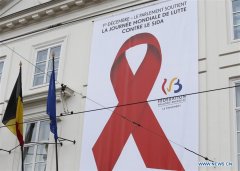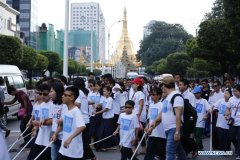Feature: Namibia's long journey toward HIV-free society
WINDHOEK, Nov. 22 (Xinhua) -- It has been more than nine years since Monika Kapofi was told that she was HIV positive.
Kapofi from Oshikango, the north central region of Namibia, says she was not saddened by the news though.
"I accepted the results and communicated them to my two elder sisters who also seemed OK with my condition," she says.
However, Kapofi later noticed some changes in the house.
"People began avoiding using the things I used. Even the children were told not to touch me. I guess they were told about my condition and so, they avoided me. I then thought about joining a support group," she says.
Today, she runs the Edundja Support Group with the help of funding from EuropeAid. The support group, Kapofi says, freed her.
"I was able to speak about HIV and my status openly. In 2007, we started community-based support groups because the existing one was far away," she recalls.
Today Kapofi says she can walk around doing her work in the community freely.
"I am no longer the way I was when I tested positive," she adds.
The medication, Kapofi says, has helped her a lot as the recent tests failed to detect the virus in her blood.
"Personally, I think being HIV positive no longer scares me. I regard myself just like any other person," she says.
Kapofi is one of the success stories of Namibia, which has been chosen by UNAIDS to launch its 2016 Global Annual World Aids Day report.
The report was launched Monday in Windhoek by President Hage Geingob and the UNAIDS executive director Michel Sidibe.
Sidibe said UNAIDS chose Namibia as a launch pad for the report due to the country's political leadership that has been consistent in fighting disease, its providing access to medical care and translating commitment into budget allocation.
Namibia had its first HIV case reported in 1989, a year before the country attained independence.
At independence, the new Namibian government crafted a number of policies to fight the disease. A report commissioned by the health ministry and launched in 2010 set out to address the prevalence of HIV.
Although its 14-percent HIV prevalence still makes it one of the many countries with a high rate, Namibia's efforts to reduce new infection and preventing mother-to-child transmission make this nation of about 2.3 million a star.
Geingob detailed Namibia's road to reducing HIV infection and death last year when he met the United Nations Secretary-General Ban Ki-moon and Sidibe at the Empress Zewditu Memorial Hospital in Addis Ababa, Ethiopia last year during the launch of the 2015 report.
Geingob told Ban Ki-Moon that ever since Namibia de-stigmatized, most people have opened up to voluntary testing and embraced treatment.
"AIDS is no longer the proverbial white elephant in the room. As a result of this, our people opened up to voluntary testing and embraced HIV-AIDS treatment. The results were phenomenal," Geingob said.
Namibia's success, he said then, was achieved by significant scaling up of resources on all fronts and a multi-faceted approach that includes awareness raising at an early age, HIV-AIDS counseling, the extension of medical infrastructure and personnel, as well the provision of life-saving medicines.
He also said Namibia has seen a drop of nearly 50 percent in new HIV infections over the last 15 years; a more than 60-percent reduction in new HIV infections among children and more than 132,000 Namibians are on anti-retroviral treatment.
"The excellent results would not have been possible if it were not for the assistance of our international partners," Geingob said, adding that his government has realized the strong link between the medical response to AIDS and the fight against poverty.
"We have, therefore, taken the additional step of declaring war on poverty, as poverty is a contributing factor to AIDS. I believe that as we progress in to putting measures in place to eradicate poverty in Namibia, the results of our AIDS response will just improve," he said.
Furthermore, he said, 95 percent of all women in Namibia have access to HIV medicines to prevent mother-to-child transmission.
In line with Geingob's stance on poverty, Namibia set out to improve the Human Development Index (HDI) from 0.542 in 2008 to 0.55 by end of 2015 /16.
Geingob hopes that Namibia will also be on fast-track in combating HIV.















